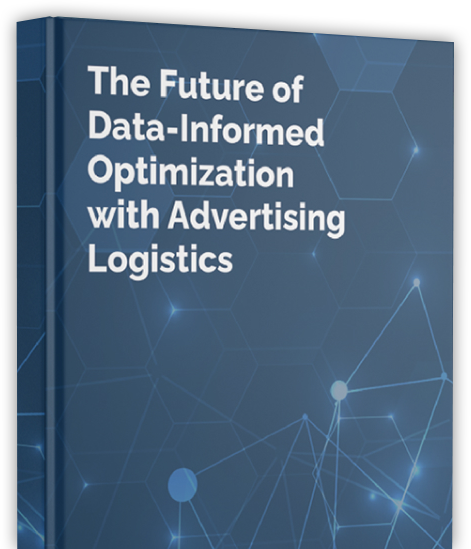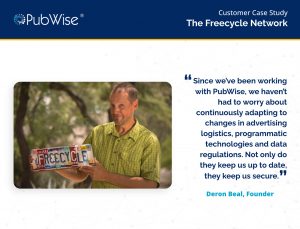Description
AdTech is in the midst of a sea of change, fueled by the depreciation of identifiers and the rapid changes in privacy and regulation. In this episode, Stephen shares his perspective on the players in this space and how they could be impacted by the end of an era (cookiepocalypse). He believes everyone in AdTech has a collective responsibility to get involved on the front side, instead of being up in arms about where we land. Join us to hear how the foundation of digital advertising is impacted by addressability and measurement, and how you can get involved.
Transcript
Tony Winders: Hello, and welcome to another edition of On the SPOT. My name is Tony Winders. And today we’ll put PubWise Founder and CTO, Stephen Johnston, On the SPOT about addressability solutions being considered by the digital advertising industry. Stephen, it’s great to speak with you again.
Stephen Johnston: Thanks for having me.
Tony Winders: A lot of solutions have been proposed over the past couple of years related to addressability and creating privacy compliance solutions in a world without third party identifiers. I know you attended an IAB Tech Lab event recently where the focus was on addressability system design. And I’m curious for your take on what options are being discussed and how close we are to making some determination of what identity and addressability solutions are going to look like in the future?
Stephen Johnston: Sure. The first place to start is, what is addressability? Addressability, loosely, is the ability for a campaign to target or address an audience, based on metrics and the types of things that you think will drive outcomes of the campaign, so it is the addressability of an audience. The reason for the teeth gnashing is that third party cookies have largely provided the surface area from a technical perspective, that addressability happens. You know some things about a person, cookie on their browser, some other company gives you a bunch of insight into them, and then you target those parameters, find that audience, and the campaign happens, the magic happens of advertising. As cookies go away, the question is, how do you maintain campaign performance when the current easy way to get an audience goes away? That’s a huge topic.
Tony Winders: Thank you for framing the discussion by starting with a definition of addressability. So what are the range of solutions being considered when third party cookies go away? And where do you see the most traction happening so far?
Stephen Johnston: I’ll probably miss one, but there are a couple of big types of replacements. And they’re driven by different expectations or needs in the market to adhere to whatever your definition of privacy is. No one woke up one day and said, “You know what I’d like to do, I’d like to kill third party cookies.” This is not a good idea. We may end up in a better place, all around, holistically. But there aren’t any key drivers to kill the cookie. That drive is primarily regulation. The sensibility of privacy and, I would say, there is some hope that there’s even better effective methods. And those have always been in the background saying, “Hey, is a third party cookie the only way to do this.” I think that should be addressed. There’s always been people who have had a counterpoint to the cookie and said that there’s another way to do this: contextual, predictive, and all these other things. And so those are the three drivers for what’s going on with the cookie. The reason that Google’s doing their thing, they’ve got 100 reasons. One of them is regulation, or incumbrance with a certain French group that says they were doing some bad things. If we put those three things, depending on which you fall into, I think you end up with different goals with the replacement technology. If you’re really a hardliner on privacy, then you’re trying to do something that doesn’t trip over any of the landmines of privacy, that doesn’t expose users at all, and it doesn’t have a risk of exposing users. There is a lot of conversation around, you can make things that feel anonymous, that mathematically aren’t really secure. So there’s this tough, cryptographic, programming problem. There’s this real tough mathematical problem of what really mathematically defines privacy. How do you hide people in a data set, and yet somehow still identify them? How do you have this forest with a bunch of people camouflaged in it, but then still tell someone that there’s 100 people that are interested in cars in that forest? So that’s the real, hardline privacy side. The other side is just pure regulation, which is based on GDPR, you don’t have to have pure mathematical privacy, there’s just certain regulations around GDPR. So there’s some sort of tension between which of those philosophies you go into. And the third one is just, what’s another method other than the cookie? That’s where stuff is being built and we’re seeing different results along the way. There’s different drawbacks, and there’s different upsides for each, and we should go through them separately.
Tony Winders: Are you landing in any particular camp personally, as to how this is going to unfold?
Stephen Johnston: For us, wanting to be a technology layer and that really being more of our role, activating these technologies, then no, I don’t. Our role is to help the publisher activate these technologies, help the publisher optimize them, and then as we move our way up into our ORTB platform, into our DSP, it’s the same thing in the other direction. Make sure that buyers have access to the signal for whichever of these solutions is appropriate. When you talk about addressability, almost everyone fails to mention measuring. You see a lot of talk about addressability, it’s like, how can we find this audience? But how can you prove that once the audience was found, which of potentially multiple campaigns with different types of targeting or different kinds of audience, actually resulted in the effect you wanted in the advertising campaign? On the flip side, we talk a lot about targeting and we talk about privacy and cookies. But there’s this other leg of measurement, which is, once the item is bought, or put in the shopping cart, or the things clicked on, the thing’s filled out, you download the white paper, how do you know which of your audiences that you were targeting across multiple campaigns, resulted in that? There’s all kinds of different ways, some of them more complex than others. So the purely predictive side, the people that are maybe ultra hardline, want to actually do predictive attribution, or predictive measurement. So it’s a little weird. It’s like, you’re going to predict the audience, and then you’re going to predict whether it worked. There’s some challenges there, it’s almost like a philosophical discussion of the nature of consciousness. How do you measure a thing you didn’t know for sure with another thing you don’t know for sure, so that you can get some amount of sureness about these things, which you now have no sureness about? It’s a little weird.
Tony Winders: It seems like it would be difficult for a performance marketer to take the predictive model seriously, if that’s the most conservative of the options, what else is being considered?
Stephen Johnston: That’s the most out there. But it’s interesting. The other option is essentially some mixture of panels in basically anonymized audiences. You find these things where you say, “As long as we have 10,000 people in a group, then we can do some things with that group, that means you can’t identify an individual in it.” It gets into some concepts of math but the basic nature of it is, you choose to randomize participation in the group, a certain amount, and it creates enough unpredictableness in the audience that mathematically, you can’t pull an individual out. And this is almost something you have to see described, essentially, what you’re doing is you’re saying, “We have a bunch of people in this audience, we know certain things about them, but we need to make sure that we know more than what you’re targeting, that there’s many of them. And then we’ve essentially randomly put some people in here that don’t meet those criteria at all.” And it’s interesting, the definition of privacy is almost an introduction of the lack of specific knowledge and a bunch of fuzzy, trust us stuff. I think there’s a lot of work to do from the industry perspective, to convince people. Once you get billed on a prediction, my system predicted it should be zero, there’s a bunch of stuff that needs to be swallowed. In the crypto space, there’s just people putting out a lot of information about their theory of why it’s better, why it meets these things. And you’ve now got, essentially, a spider diagram of considerations. It used to just be, how do we do the targeting best? How do we do the targeting, how do we do the measurement, and let’s get the best solution that we can. Well, that created a bunch of data concerns, privacy concerns, all these other concerns. And now they’re coming back saying, “Hey, we need to redo this. We have to target, we have to get addressability, and we have to measure, but we need to meet the privacy concerns, the regulation concerns, and the go forward technology concerns, not using a cookie.” And in that space, there’s some give or take, it’s going to be less perfect.
Tony Winders: So you’ve described both a predictive and panel based approach, are there other alternatives under consideration that come to mind?
Stephen Johnston: There’s some that really don’t fall into the area of just plain consent. If you can get a person to specifically say, “I’m okay with you doing all these things.” Then you can do whatever you want. And that sounds glib, but I’m talking about it in a pure sense of, in an honest transaction, exchange of value, if you can make the case to the consumer that this exchange of value is proper, you can convince them that you’ll handle the data in a certain way, then they may tell you that you can do all sorts of things with it. And in that, you don’t fall under GDPR, the consumer has given up a certain amount of privacy to participate.
Tony Winders: It becomes first party data at that point, right?
Stephen Johnston: Yes. The tricky part is, even with first party data or zero party and all this non-third party, we’ve got to activate it. But there’s still got to be some work done to close the loop on measurement. That’s still going to take industry participation, simple as that. The other kind of big item in the space is this concept of neutral third parties, who hold part of the anonymized transaction, and almost work like escrow.
Tony Winders: Like LiveRamp, for example.
Stephen Johnston: LiveRamp is sort of in that, but you’re thinking DMP. I’m talking about non-government entities. Think of it more like an escrow company. It’s a thing that doesn’t really exist and you kind of wouldn’t want your DMP to be in this position because they’re not neutral. The browser’s are making their case that they should be the neutral party, which seems folly to me, and what they’re saying is, that if you give us the audience, and then you give us the targeting, we’ll make that happen. And then we’ll provide both of you information for the measurement and we’ll be the magic third party that will never share, leak, or otherwise, and then they’re going to do some things inside of that to make it secure. It feels like something like that ends up existing. I think that the degree to which it’s involved in every transaction is interesting.
Tony Winders: That sounds like it’s in the realm of self sovereign identity discussions happening in blockchain and web three circles, and a bit like the fox guarding the henhouse.
Stephen Johnston: When we talk about the internet, we’ve had these neutral third parties like ICANN. But they primarily dealt with regulation, specs, W3C is kind of a neutral party, right? You can lean that towards an industry group. But while they have a lot of influence, those groups don’t always have a tremendous amount of responsibility. And I don’t mean that to disparage them, I just mean that their effort is mostly outbound. In so much as they’re making good recommendations, and they’re stewarding that process properly, that’s a lot of responsibility. But they’re not two-way interchange consumers like a credit card company. That model is imperfect, but, I look at, ICANN used to give out all the domain names, and they basically said, “We’re going to regulate how you do that, we’re going to regulate the price you charge, and we’re going to do this so that you can make enough money to maintain this process for everyone.” And it feels like there will be something to fill in that role. The other interesting thing that came out of all this, Google’s been making all these things like FloC, and FLEDGE, and now they’ve got Topics API. One of the Google representatives was there and it seemed like they were very much wanting to shift their tone to, “We’re making these recommendations in order to get your feedback”, not to say, “This is the way we want to do it, and only if you squeal, are we gonna do it another way.” They really do want it to be collaborative, as collaborative as the 900 pound gorilla can be. But they do want the right solution, because the wrong solution will kill their browser. The wrong solution will introduce an opportunity for Mozilla or someone to fork Chrome and call it, “Google screwed up advertising Chrome 2.0.” So they are both personally invested from what they’re saying, and I think they’re systemically invested in getting it right. I do want to say, for anyone who is involved in this from an ad tech perspective, I would start giving feedback, I would get involved in that process. Because one of the other questions I asked them was, “How are they going to measure when it was right?” and they basically said, “Well, we don’t really have a standard idea of that.” So traditionally, the definition of “right” in those situations becomes “when the feedback drops to the point where it’s an acceptable background radiation.” If you’ve got a problem, you better be out there saying it. Don’t rely on other people and rely on some data wonk at Google who is actually counting numbers and numbers go up, it’s bad, and they go way down, it’s probably good.
Tony Winders: So as a self regulated industry, that is our process, right?
Stephen Johnston: Well, Google’s got their own thing they’re doing in the browser, and you can participate in what’s called origin tests. If you just look for Google origin tests, this gave me some real technical stuff that most publishers probably won’t really get involved in. But it’s interesting that actually in the browser, you can enable these tests and you can participate in them. And they’re doing that on GitHub, they’re doing that relatively in the open. You can provide a lot of feedback through there, they’re clearly responsive to it, they heard the feedback that FloC was not going to work. Then you’ve got the working groups making recommendations. It falls into that, that the IAB can make recommendations, they’re influential, there’s a lot of people involved. Google’s going to do their own thing in the browser, but they are motivated to get it right, otherwise it causes problems for them all around. They’ve also indicated that the group working on Chrome, is only communicating through those public channels, even internally. So in other words, the AdX team doesn’t have direct communication with the Chrome team, when the Chrome team says we’re making a change to the browser or we’re proposing a change, everyone, including Google’s ad side of the house, hears that at the same time. Which is good to hear. I think it’s proper from a competitive perspective. And you could really talk for hours about it, it’s deep and wide, and impactful. This is the foundation of digital advertising when you talk about addressability and measurement. Otherwise, what you have is billboards, a crapload of billboards on the web. That’s not really been the promise of digital advertising.
Tony Winders: No, it has not, that would seem like a big step backwards to me. Well, Stephen, we’ll have to leave it there for today. But this has been really helpful to hear firsthand what digital advertising industry leaders are thinking about and the range of solutions under discussion for identity and addressability systems in a world without third party cookies. I look forward to keeping in touch with you about this, as the industry conversation continues to unfold. This has been another edition of On the SPOT. I’d like to thank our audience for listening. And as always, our expert guest, Stephen Johnston, Founder and CTO of PubWise. We hope you’ll join us for another episode soon. And thanks again, Stephen.
Stephen Johnston: Thanks.





